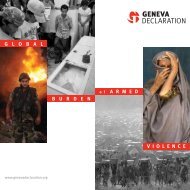Tackling Violence against Women: From Knowledge to Practical
Tackling Violence against Women: From Knowledge to Practical
Tackling Violence against Women: From Knowledge to Practical
Create successful ePaper yourself
Turn your PDF publications into a flip-book with our unique Google optimized e-Paper software.
introduction<br />
Although the number of women who are violently injured and killed each<br />
year worldwide is not known with any precision, available evidence, while<br />
unsystematic and incomplete, already indicates that violence <strong>against</strong><br />
women (VAw) is ‘a universal problem of epidemic proportions’ (UNIFEM,<br />
2007). VAw occurs in both conflict and non-conflict situations. It is often less<br />
evident in its occurrence and effects than the deaths and injuries of men as<br />
combatants in armed conflicts or as gang members in violence related <strong>to</strong><br />
drug wars. Yet women and girls are often victimized or adversely affected in<br />
other ways in these and all other armed violence settings. women and girls<br />
are also common targets of sexual violence in armed conflict and fragmented<br />
societies, and they suffer disproportionately from its indirect consequences.<br />
In non-conflict situations, women are the victims of intimate-partner (or<br />
‘domestic’) and sexual violence, honour killings, and dowry-related violence<br />
(gD Secretariat, 2008b).<br />
The economic costs associated with armed violence are tremendous. It is<br />
estimated that the annual economic cost of armed violence in terms of lost<br />
productivity due <strong>to</strong> violent homicides is between USD 95 billion and USD 163<br />
billion alone (gD Secretariat, 2008b, p. 89). Additional costs include medical<br />
costs associated with treating the injured or indirect costs such as loss of<br />
income from the victim’s inability <strong>to</strong> work. However, a focus on costs ignores<br />
the wider relationship among armed violence, livelihood perspectives,<br />
development, and the (indirect) impact on women and men. The gendered<br />
dynamic of these relationships is complex. As the Organisation for Economic<br />
Co-operation and Development (OECD) states:<br />
when husbands are killed, women frequently lose their access <strong>to</strong> farmlands and<br />
the right <strong>to</strong> live in their marital homes. The resulting survival choice for many<br />
affected women and children is prostitution, commercial labour or domestic<br />
servitude. This has consequences for ongoing exposure <strong>to</strong> violence and ill<br />
health from communicable diseases and poor working conditions, as well as<br />
future community exclusion (OECD, 2009, p. 32).<br />
The geneva Declaration on Armed <strong>Violence</strong> and Development (gD) is a<br />
diplomatic initiative built around the recognition that armed violence and<br />
9<br />
iNTRoDUcTioN<br />
i<br />
ii









